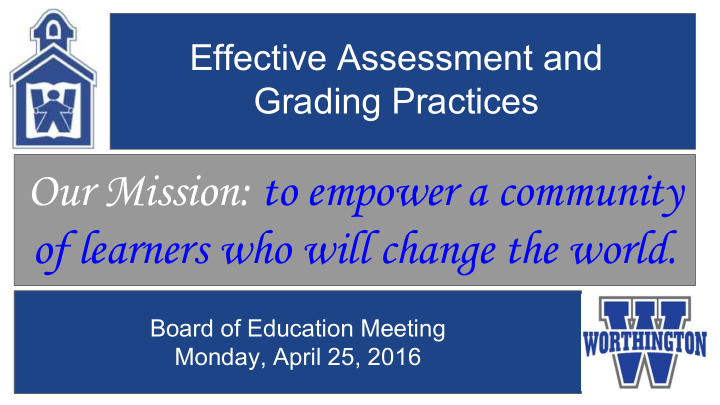



Effective Assessment and Grading Practices Our Mission: to empower a community of learners who will change the world. Board of Education Meeting Monday, April 25, 2016
Purpose of the Presentation ● To share the district’s aligned approach to promoting effective assessment/grading practices which: ○ Maximize student achievement & growth; ○ Foster student ownership of learning; ○ Create space for creativity & critical thinking.
Our Mission To empower a community of learners who will change the world.
Why Grading Practices? ● In our professional development journey with Formative Instructional Practices, Teacher-Based Teams, and Growth Mindset, this is an essential, and big, next step.
Key Considerations ● “Can teachers use their grading practices to shift the focus from a mythical destination students are supposed to reach to the journey and learning experience itself?” Purcell ● “A grade should not be compensation but communication.” Wormeli ● “...(grading) practices are not the result of careful thought or sound evidence, ...rather, they are used because teachers experiences these practices as students and, having little training or experience with other options, continue their use.” Gusky ● “Grades are first and foremost communication; they are information, nothing more. The moment we make them something more, we corrupt their constructive use.” Wormeli ● “Grading should not be treated as a motivator to students in the context of ‘learn or I will hurt you.’” Wormeli
Assessment and Grading Practices Expert, Dave Nagel
Leading with the Right Questions ● How can assessments and grades be used to foster creativity and student ownership? ● If 90%=A, 80%=B, 70%=C, and 60%=D, what should be an “F”? ● Should “re-do’s” be accepted? ● What is the impact of assessments and grades on student learning?
Mission of Grades Reliable Mission of Truthful Understandable Grades Impartial
Our Current Work ● Continuation of Formative Instructional Practices ● Administrative Team - Nagel Book Study ● Monitoring Quarterly D’s/F’s ● Preparing for Learning Leaders Academy May 31-June 1 ● Monitoring Credit Recovery and Summer School Programs
Moving Forward ● Tradition must not trump evidence. ● Begin with why. ● Build a clear plan. ● Learning Leaders Academy - All Secondary Staff ● Building Leadership Team / Staff - Nagel Book Study ● Embedded Focus Area in Professional Development ● Parent Engagement
Revising the Elementary “Grade Card” ● To be a “Standards-Based” report of student PROGRESS ● To communicate key learning as reflected in the Ohio Learning Standards ● To simplify, where possible, and make the report more easily understood and useful in communicating individual student progress. ● To reflect consistency in reflecting the Worthington Academic Program district-wide ● To reduce the number of “Marking Keys”, and simplify overall understanding ● Maintain letter grades in grades 4-6, while providing specific feedback about key aspects of the content that is graded
● Defining our Belief about Progress Belief Statement for Assessing and Reporting Student Progress In Worthington Schools, we believe that assessing and reporting student progress is important. Evaluating student progress takes place daily through a variety of tasks, work samples, and assessments including observations of student performance. Assessment information helps to guide student learning, as well as teachers’ instruction in meeting each student’s needs in the process of learning. Explicit feedback and guidance to families supports each student’s opportunity for success in meeting standards and achieving his/her potential.
● The Purpose of The Progress Report The Worthington Schools’ Progress Report is designed to communicate individual learning to students and their families. Therefore, the student progress report should: ● Be clearly understood by teachers, students, and families. ● Provide a concise and consistent communication of student performance and growth, over time, based on The Ohio Learning Standards. ● Promote ongoing communication between schools and families in supporting each student and his/her success.
A Common, Unifying Marking Key MARKING KEY The NUMBER is not as important as the The number and its descriptor indicate the level at DESCRIPTOR which: which a student is progressing on any standard ● Notes the degree to which the Student consistently exceeds and extends grade level expectations 4 student is working independently demonstrating in-depth knowledge, self-motivation, and a toward or meeting higher order thinking skills. the standard ● Describes the level of independence Student consistently meets grade level expectations with independence. 3 or mastery of the (“3” indicates the EXPECTED level of performance for any student standard at any grade level .) Note: A “3” is the EXPECTED level of Student is working at or near basic understanding of grade level 2 student performance to expectations, with support. be successful at that grade. 1 Student is working below grade level expectations while requiring ongoing interventions/support.
A Sample of the Standards-Based Format Progress Marks speak to standards of strength, and specific places where improvement is needed. At Grades 4-6, Achievement “Grades” are amplified through the specific strengths and areas for improvement noted in the standards statements.
Communicating with Teachers and Parents In the Fall, 2016: ● Teachers will have training on the revised Progress Reports AND receive “A Teacher’s Guide to Progress Reports” to facilitate their use/understanding of the revisions. ● Parents will receive “A Parent’s Guide to Progress Reports” to support their understanding of the revisions.
Closing To empower a community of learners who will change the world.
Recommend
More recommend